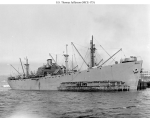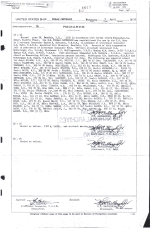Decommissioned 11 May 1942
"Commandant, 14th Naval District, letter of 1 April 1942 directed his Personnel Officer and the Naval Transportation Service officer assigned to his district stating that he had
been directed by a secret CinCPac dispatch of the same date to take over SS Thomas Jefferson and to man her with a naval crew and naval officers.
The Commandant directed that the vessel be fueled and provisioned for an extended cruise of about 50 days, that she be placed in commission as a US Naval Vessel and
supplied with all necessary communication codes and ciphers. He directed his Personnel Officer to call to active duty any naval reserve personnel on inactive duty that
were on board the ship, including the ship's captain despite the fact that he was overage. The Personnel Officer was also to canvas the remainder of the crew and recruit
them if possible into the Navy for temporary duty, it being highly important to retain as many of the old crew as possible. It was very important to meet these
requirements immediately and to have the vessel ready for sailing by 2 April 1942 (the day after the letter was written). According to the ship's deck log,
Thomas Jefferson, a new Liberty ship which had been operating as a nitrate carrier, was commissioned at Honolulu on 1 April 1942, departed that port on 3 April,
arrived at Midway Island on 8 April, and remained there until 12 April. A radio message of 4 April from Fort Shafter (Honolulu) to Washington identified the ship,
stated that she had sailed, and listed her cargo as 1,000,000 rations, 150 tons milk, 340 tons meat, 200 tons rice, 20 tons cigarettes, and 548 tons ammunition.
This information was to be passed to the "Supreme Commander in Australia and the Philippines." A second radio message, also from Fort Shafter to Washington and dated
11 Apr 42, reported that CinCPac had recalled the ship to Honolulu.
VCNO issued instructions to the Bureau of Ships regarding this ship on 6 Apr 42, stating that Com14 had been authorized to accept delivery of this WSA-owned vessel
at Honolulu and did so at 1330 hours, 1 Apr 42. The ship was to be classed as a cargo vessel (AK). On 11 Apr 42 the Auxiliary Vessels Board provided formal authority
for the acquisition of the ship by recommending that she be taken over. BuShips wrote to WSA on 13 April to sort out the administrative details of the transfer, and on
the same date the name Corvus and hull number AK-57 were recommended by VCNO and approved by SecNav for the ex-Thomas Jefferson. But also
on 13 April, presumably later in the day, VCNO directed BuShips to cancel his previous directives regarding acquisition of this ship, stating that she was to be
returned to WSA at San Francisco. On 16 Apr 42 VCNO cancelled the name Corvus and the designation AK-57 that had been approved for the ship on 13 Apr 42.
The ship's deck log (held by the National Archives but attributed to the World War II Navy's other Thomas Jefferson (APA-30) shows that she returned to
Honolulu on 18 Apr 42, remained there until the 25th, and then sailed in convoy for San Francisco, arriving on 6 May 42. She was decommissioned there on 11 May 42 and
delivered to agents for the Waterman Steamship Co., which had operated the ship for WSA before the Navy took her over. Maritime Commission records concur with this
chronology, showing the ship in Navy hands between 1 Apr 42 and 11 May 42. Later Navy records do not show this vessel as a Navy ship, and the hull number AK-57 was
officially listed as "not used." The ship probably never received word that it had been renamed Corvus, an astronomical name that was later reused for AKA-26.
Courtesy Shipscribe.com.
This operation appears to have been a desperate effort to re-provision Corregidor as the rest of the Philippines fell to the Japanese. The fall of Bataan on 9 Apr 42
may have persuaded CinCPac that a Liberty ship had no chance of delivering a cargo to the besieged fortress, which finally fell on 6 May 42. For her part,
SS Thomas Jefferson was operated by Waterman for the remainder of the war."
Courtesy Shipscribe.com.

